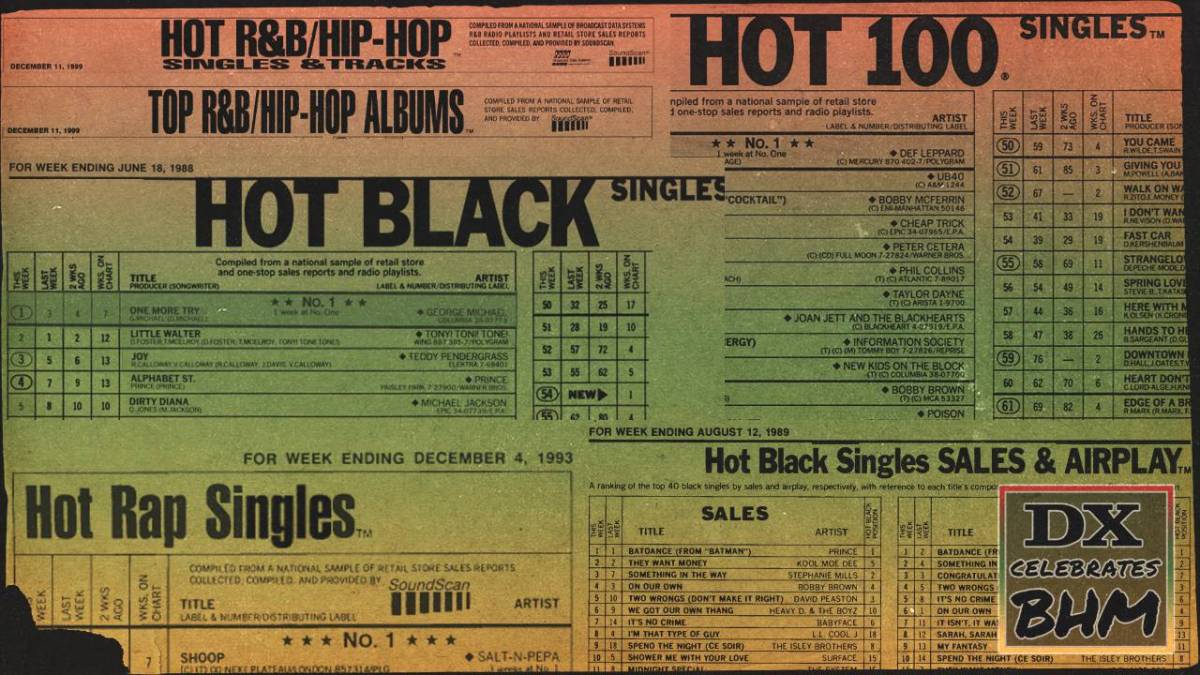Billboard is the go-to platform when it comes to seeking chart success. Artists fight for the No. 1 spot on the outlet’s various charts and there have been some controversial moments over the years that made the public question the validity of Billboard‘s chart process.
Black music, more specifically Hip Hop, has been underrepresented on Billboard’s charts. Black music has gone through a variation of names and artists like LL Cool J, Salt-N-Pepa, DMX, and Wu-Tang Clan were considered R&B acts by Billboard’s standards. As Hip Hop grew in popularity, it lapped other genres like rock and pop, but just wouldn’t be recognized by any of the major platforms.
It wasn’t until the turn of the century, where Hip Hop, a genre that’s been around since the late 1970s, got its proper recognition. The early 2000s saw Hip Hop become a mainstream force crushing sales and radio airplay but very little attention was given to it on the chart side.
The present days sees these charts reflect Hip Hop somewhat fairly, although there are 17 different charts — the most out of any genre. While rappers such as Drake, Cardi B, Lil Uzi Vert, NBA Youngboy, Lil Baby and more dominate the mainstream landscape of the 2020s as Hip Hop became the most consumed genre of music, that wasn’t always the case with a major lack of representation in earlier decades.
Check out our timeline going through Hip Hop’s fight for chart superiority below.
1940-1960 – Billboard Recognizes Black Music For The First Time
Billboard‘s first acknowledgment of Black music came in October 1942, where they launched a chart called the Harlem Hit Parade that ranked the most popular songs to come out of Harlem. Many considered Harlem to be the Black capital of America at the time, and jazz became a popular genre through the neighborhood’s nightlife. The Harlem Hit Parade is considered the precursor to the current Hot R&B/Hip Hop Songs chart we have today.
While the chart included black artists on this list, white artists held the top spots like Bing Crosby and Freddie Slack. Between the ’40s and ’60s, the Black music charts went through various names like Race Records, Rhythm & Blues Records, Hot R&B Sides and more. It wasn’t until 1965 where albums by Black artists were recognized under Hot R&B LPs.
1979 – Michael Jackson Breaks The Urban Radio Promo Mold
Michael Jackson made a name for himself as the Jackson 5 frontman, but the Gary, Indiana native solidified his global solo superstar status with 1979’s Off The Wall. Once Epic Records got their hands on “Don’t Stop ‘Til You Get Enough,” they knew they were sitting on a gold mine.
In order to cast the widest audience net possible, the marketing team made the shrewd yet unorthodox decision to promote directly to both pop and R&B radio, rather than the usual building through urban radio before then bubbling over into the pop world.
The unprecedented decision paid dividends when MJ’s Off The Wall lead single went No.1 on both the R&B (Hot Soul Singles) and Billboard Hot 100 charts in October 1979. His first solo No. 1 since 1972’s “Ben.”
“Our whole mindset was that we were making music for the masses, and part of the big picture was to get the record company to turn around and market and promote to a mass market,” said Jackson’s co-manager Ron Weisner. “If you were a black artist, you were put in a black music division, and that meant the marketing campaign was an ad in Jet and Ebony. Our attitude was, ‘Let the public decide — don’t just present it to a black market only.’”
1980 – Rap Is Here & It’s Invading The R&B Charts
Hip Hop arrived on the mainstream music scene’s doorstep in 1980 and it was ready to bust down any door gatekeepers were using to keep it on the outside. At the top of the year, Sugarhill Gang’s “Rapper’s Delight” jumped to No. 4 on the Hot Soul Singles chart. Months later, Kurtis Blow’s “The Breaks,” which is Hip Hop’s first gold single, also reached No. 4 on the R&B chart.
The Hot Soul Singles chart would be renamed to the Hot Black Singles in 1982 and Afrika Bambaataa & the Soulsonic Force’s “Planet Rock” and Grandmaster Flash & the Furious Five’s “The Message” also eerily topped out at No. 4.
The only Hip Hop tracks to nab the No. 1 spot on the Hot Black Singles chart would come at the end of the decade in 1987 with LL COOL J’s fairy tale “I Need Love” and De La Soul’s groovy “Me Myself & I” in 1989.
1990 – Rap Is Undeniable But It Takes Billboard a Decade to Recognize it
After calling it Hot Black Singles for eight years, Billboard changed their Black music singles chart to Hot R&B Singles in October 1990. Hip Hop was at the peak of its golden age during this time, where it broke into the mainstream thanks to artists such as MC Hammer, Public Enemy and Dr. Dre.
Hip Hop received very little support from Black radio, which didn’t help its case with bigger radio stations. But it didn’t stop Hip Hop from becoming the best-selling music genre in the mid-90s and then soon the top-selling genre by 1999.
With the introduction of SoundScan technology in 1991, Billboard was able to tally retail sales on music purchases more accurately. With Hip Hop selling more CDs, artists like The Notorious B.I.G, 2Pac, Missy Elliott, Snoop Dogg and more would top the Hot R&B singles chart. SoundScan changed the game, especially for the Hot 100, where genres like Hip Hop received a boost from physical sales. However, as Hip Hop continued to blow up, Billboard still considered it to be R&B for over nine years.
That was until December 1999 where Billboard finally added Hip Hop to the name in the singles and albums chart. The Hot R&B Singles chart became the Hot R&B/Hip-Hop Singles & Tracks and Top R&B Albums became Top R&B/Hip Hop Albums to recognize Hip Hop’s influence and relationship to the genre.
2000 – Black Artists Rule Billboard Charts But The Dawn Of The Digital Era Shook Things Up
The Hip Hop-pop crossover in the 2000s was the first time Black artists occupied so many spots in the top ten of Billboard‘s Hot 100 chart. Hip Hop had become the preferred genre of music by teenagers and young adults and with the help of radio, artists like JAY-Z, DMX, 50 Cent, Ludacris and more became mainstays on the charts. In 2004, Billboard created the Top Rap Albums chart.
However, in the mid-2000s, Apple unleashed iTunes to the masses, and it would be the first time that consumers would be able to get their music with a few clicks on their computers. The massive influx of digital singles and albums forced Billboard to accommodate digital sales on their charts, but they wouldn’t do the same for their Black music charts.
Billboard counted only physical sales and radio plays for Black music, but the problem with that was the digital era began phasing those two out considerably. Regional scenes like the South and Midwest were blowing up with artists who no longer needed to release music the old-fashioned way thanks to the internet being at their disposal. Hip Hop’s popularity elevated at the start of the digital era, but it wouldn’t be until a decade or so later that Billboard would catch on.
2012 – Billboard Makes Changes To Hip-Hop/R&B Chart Formula
Billboard made changes to their formula impacting R&B/Hip-Hop charts to better reflect an audience fully moving to digital streaming consumption. iTunes purchases and streams were now counted regardless of the consumer instead of relying on terrestrial radio, which was already the case on the Hot 100.
This caused some confusion on the genre-specific charts with an example being Rihanna’s “Diamonds” shooting to No. 1 on the R&B Songs chart from outside the top 50 in one week without any airplay from R&B stations.
Take a look at the Hot Rap Songs in late 2012 and its even more mind-boggling to find Psy’s viral dance anthem “Gangnam Style” topping the chart without remotely containing any elements of Hip Hop.
2019 – “Old Town Road” Causes “Trap” Country Chart Drama
The relatively unknown Lil Nas X began to pick up serious steam with his Billy Ray Cyrus-assisted “Old Town Road,” which he dubbed to be “country-trap.” After signing to Columbia Records in March, “Old Town Road” impacted the country charts and Billboard’s chart team was forced to make a tough decision.
Billboard ultimately scrubbed the diamond-certified anthem from the Hot Country Songs chart in March, citing that the Sony team in Nashville wasn’t being involved and Columbia not pushing it as “country.”
Nas X wasn’t upset about the move, as he continued to dominate the Hip Hop charts and surge up the Hot 100, where he patrolled for a record 19 weeks at the top. But the Atlanta native pointed to tracks such as Florida Georgia Line and Bebe Rexha’s “Meant to Be” containing “trap drums” but still being categorized in the country section.
All isn’t lost with Nas X possibly paving the way for the next borderline “country-trap” banger coming after him, as the genre lines only continue to get blurrier as time goes on.
“We made the decision we felt was consistent,” Billboard senior VP of charts Silvio Pietroluongo said in September 2019. “We understand that everyone hears music differently, so we understand how people can look at that and think differently.”
In 2020, 17 out of the 32 Billboard-topping albums were Hip Hop and/or R&B. As the genres continue to blaze musical lineage, it iss vital history be documented properly, accurately, and most importantly, fairly.




